Mexico’s economic growth has historically been slow, averaging just over 2% a year between 1980 and 2022 lagging behind other Latin American countries. However, you’d never guess this if you visited Laredo. The crossing is a major trade hub where more than $800 million worth of goods—from auto parts to avocados—cross the border every day. In October 2022 alone, about $27 billion worth of products moved through Laredo, surpassing even the busy ports of Los Angeles and Long Beach.

Post-COVID Investment Boom
Since the COVID-19 pandemic, Mexico has seen a surge in foreign investments, more than any other emerging market. Big companies like Tesla, Samsung, Honeywell, Medtronic, and General Motors are pouring billions of dollars into the country. This is largely due to a strategy called nearshoring, where companies move their production closer to their customers to save on costs and avoid supply chain issues.
Why Nearshoring is Gaining Popularity
Several global events have made nearshoring even more attractive. China’s strict COVID-19 lockdowns, the pandemic’s supply chain disruptions, and geopolitical issues like the war in Ukraine have pushed companies to rethink their manufacturing locations. Recent disruptions in the Suez and Panama Canals due to conflicts and droughts have further highlighted the need for more reliable supply chains.
Trade Deals and Balanced Trade
Mexico’s free trade agreements, particularly the USMCA, allow duty-free movement of goods between the U.S., Canada, and Mexico. This has propelled Mexico to become the U.S.’s largest trading partner by July 2023, surpassing China and Canada. Unlike the trade imbalance with China, U.S.-Mexico trade is more balanced, fostering mutual economic benefit.

Source: Statista
The Volatile Peso
The increased interest in nearshoring has impacted the Mexican peso, making it one of the most volatile currencies against the U.S. dollar. This volatility offers lucrative opportunities for foreign exchange traders. Paul Houston, a leading figure in foreign exchange products, noted a “24% increase in notional volume” for Mexican peso futures in 2023.

Want to trade futures? Get in touch, we’ll send you a demo egonzalez@tvmarkets.com
A Promising Future
The USMCA has created a $1.3 trillion trade corridor between the U.S., Mexico, and Canada, up from $343 billion when NAFTA was signed in 1994. If nearshoring continues to grow, Mexico could see its manufacturing exports to the U.S. increase to $600 billion by 2028, from about $455 billion now. Investments might also rise to $46 billion, boosting Mexico’s annual GDP growth to around 3% between 2025 and 2027, compared to an estimated 1.9% in 2022.
Mexico is home to about 140 listed companies, including subsidiaries of U.S. giants like Walmart (WALMEX) and Kimberly-Clark (Kimberly-Clark de México). Coca-Cola’s largest bottling partner, FEMSA, is also based there.
Strong railway connections between Mexico and the U.S. exist thanks to companies like Kansas City Southern (CP). Central del Norte (OMAB) further bolsters infrastructure with its network of airports and manufacturing parks across the country, particularly in the northeast’s manufacturing hub, Nuevo León, with its capital Monterrey being a prime location for manufacturers.
Conclusion
Mexico’s strategic location, strong trade agreements, and rising foreign investments make it a crucial player in global manufacturing and trade. With nearshoring on the rise, Mexico’s future looks bright, promising more balanced and sustainable economic growth in the years ahead.
Open an account and start investing here
https://www.tradeviewlatam.com/en/forms/accounts/individual/EG
Sources







